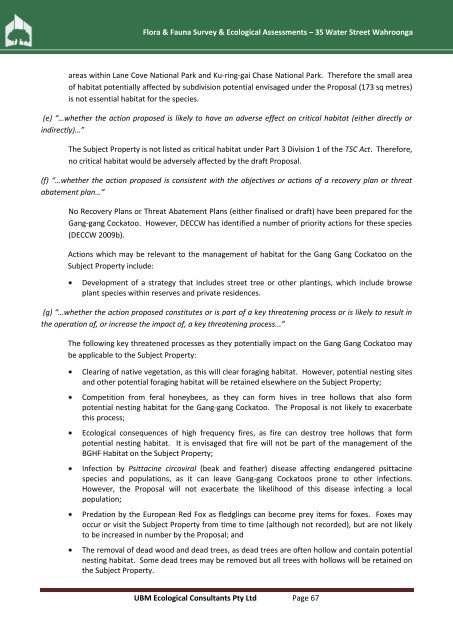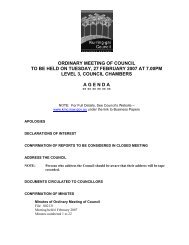Flora & Fauna Survey & Ecological Assessment (pdf. 5MB)
Flora & Fauna Survey & Ecological Assessment (pdf. 5MB)
Flora & Fauna Survey & Ecological Assessment (pdf. 5MB)
Create successful ePaper yourself
Turn your PDF publications into a flip-book with our unique Google optimized e-Paper software.
<strong>Flora</strong> & <strong>Fauna</strong> <strong>Survey</strong> & <strong>Ecological</strong> <strong>Assessment</strong>s – 35 Water Street Wahroonga<br />
areas within Lane Cove National Park and Ku-ring-gai Chase National Park. Therefore the small area<br />
of habitat potentially affected by subdivision potential envisaged under the Proposal (173 sq metres)<br />
is not essential habitat for the species.<br />
(e) “…whether the action proposed is likely to have an adverse effect on critical habitat (either directly or<br />
indirectly)…”<br />
The Subject Property is not listed as critical habitat under Part 3 Division 1 of the TSC Act. Therefore,<br />
no critical habitat would be adversely affected by the draft Proposal.<br />
(f) “…whether the action proposed is consistent with the objectives or actions of a recovery plan or threat<br />
abatement plan…”<br />
No Recovery Plans or Threat Abatement Plans (either finalised or draft) have been prepared for the<br />
Gang-gang Cockatoo. However, DECCW has identified a number of priority actions for these species<br />
(DECCW 2009b).<br />
Actions which may be relevant to the management of habitat for the Gang Gang Cockatoo on the<br />
Subject Property include:<br />
Development of a strategy that includes street tree or other plantings, which include browse<br />
plant species within reserves and private residences.<br />
(g) “…whether the action proposed constitutes or is part of a key threatening process or is likely to result in<br />
the operation of, or increase the impact of, a key threatening process...”<br />
The following key threatened processes as they potentially impact on the Gang Gang Cockatoo may<br />
be applicable to the Subject Property:<br />
Clearing of native vegetation, as this will clear foraging habitat. However, potential nesting sites<br />
and other potential foraging habitat will be retained elsewhere on the Subject Property;<br />
Competition from feral honeybees, as they can form hives in tree hollows that also form<br />
potential nesting habitat for the Gang-gang Cockatoo. The Proposal is not likely to exacerbate<br />
this process;<br />
<strong>Ecological</strong> consequences of high frequency fires, as fire can destroy tree hollows that form<br />
potential nesting habitat. It is envisaged that fire will not be part of the management of the<br />
BGHF Habitat on the Subject Property;<br />
Infection by Psittacine circoviral (beak and feather) disease affecting endangered psittacine<br />
species and populations, as it can leave Gang-gang Cockatoos prone to other infections.<br />
However, the Proposal will not exacerbate the likelihood of this disease infecting a local<br />
population;<br />
Predation by the European Red Fox as fledglings can become prey items for foxes. Foxes may<br />
occur or visit the Subject Property from time to time (although not recorded), but are not likely<br />
to be increased in number by the Proposal; and<br />
The removal of dead wood and dead trees, as dead trees are often hollow and contain potential<br />
nesting habitat. Some dead trees may be removed but all trees with hollows will be retained on<br />
the Subject Property.<br />
UBM <strong>Ecological</strong> Consultants Pty Ltd Page 67

















